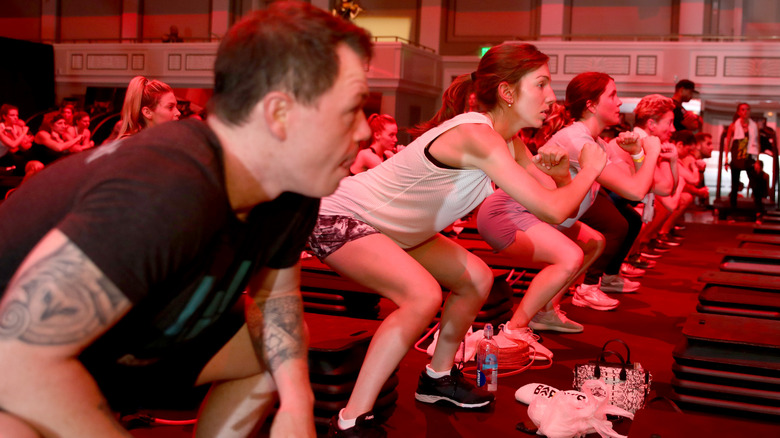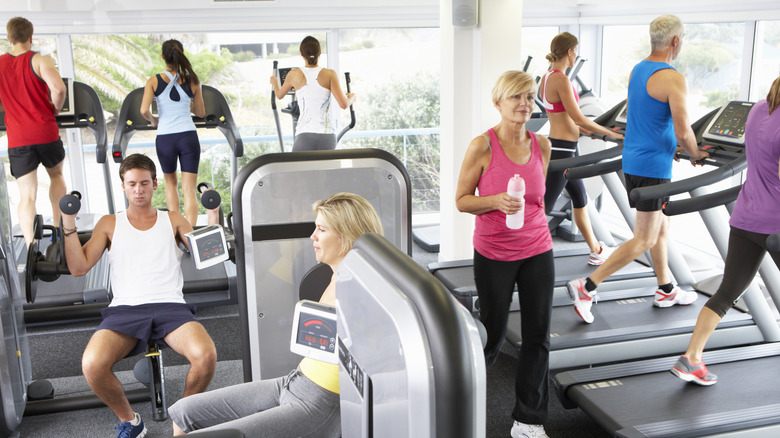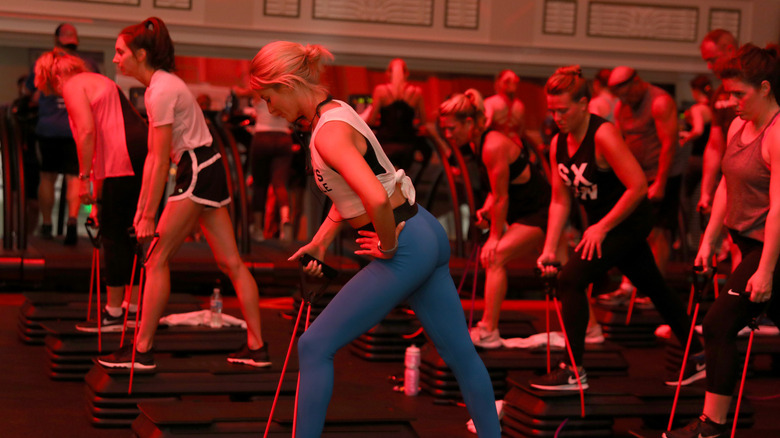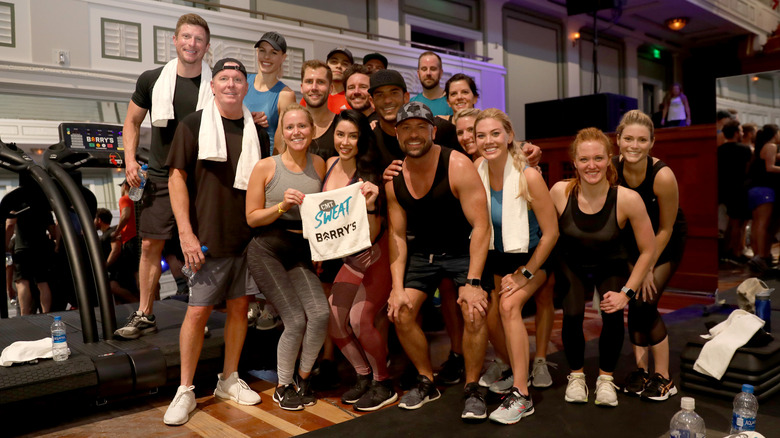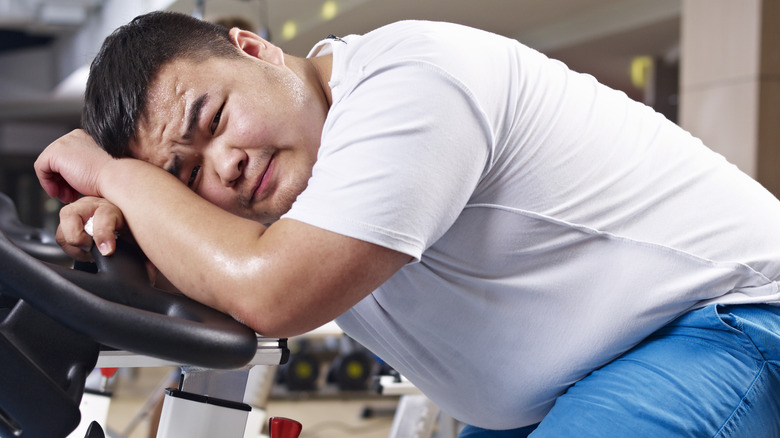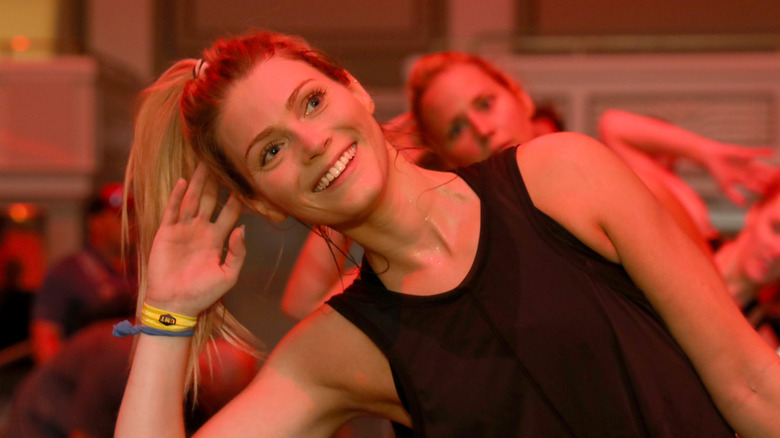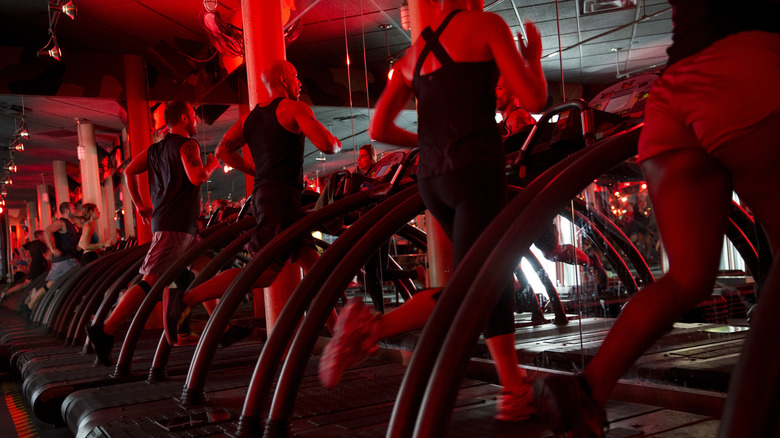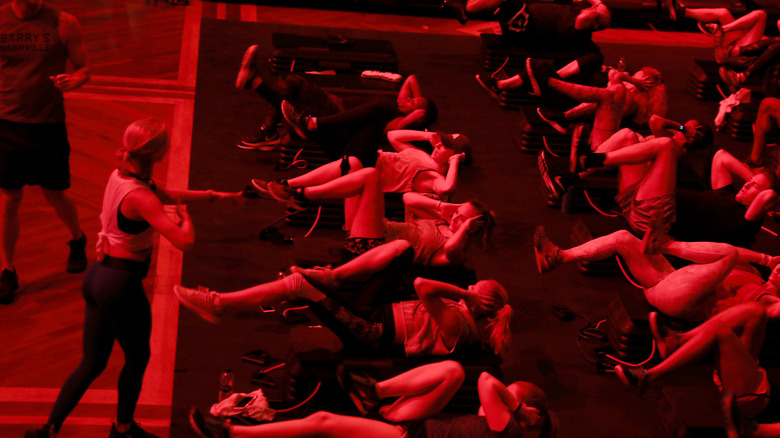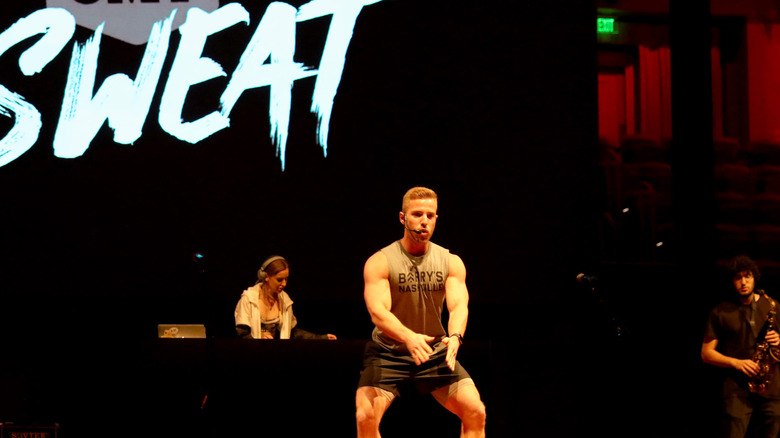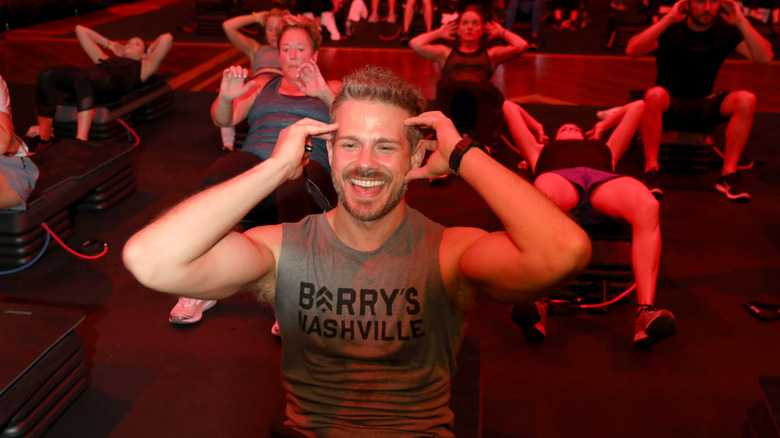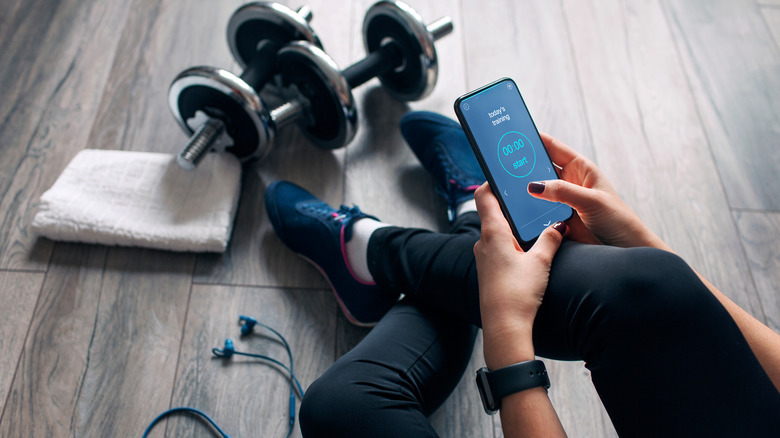All About Barry's Bootcamp, A Group HIIT Workout
Co-founded by celebrity trainer Barry Jay, the first Barry's Bootcamp was launched in West Hollywood, California in 1998 (via Barry's Bootcamp Australia). Since then, Barry's Bootcamp has attained worldwide fame as one of the most challenging and effective workouts for burning body fat and toning muscles, reports Newsweek.
Tens of thousands of devotees in 42 locations throughout the world are breaking a serious sweat in this trendy workout, including the likes of celebrities such as Kim Kardashian and the Beckhams. Barry's classes take place in a dimly lit, mirror-walled studio with red lights, loud music, and trained instructors to coach and spur you on. Alternating between strength training with weights and cardio on a treadmill, the circuit-type workouts last 55 minutes and focus on a different muscle group each day, per the website. A minimum of three classes per week is recommended, though a routine of five classes each week is optimal. Barry's Bootcamp enthusiasts may notice changes in how they look and feel in as soon as two weeks.
The key to the effectiveness of Barry's Bootcamp is maintaining an elevated heart rate throughout the workout by integrating intense bursts of both weightlifting and sprinting intervals with recovery periods. According to the website, you can burn up to 1000 calories or more in a Barry's class. Moreover, the higher resting metabolic rate resulting from greater muscle mass will continue to burn calories and melt away body fat even after the workout is over.
The Barry's workout
At its core, a Barry's class is a one-stop-shop cardio and strength training workout (via Barry's Bootcamp). The workout targets different opposing muscle groups each week to achieve a well-rounded workout with sufficient recovery periods.
As described by Women's Health, each participant devotes about half of the one-hour class to cardio doing high-intensity interval training (HIIT) on a treadmill while muscling up with resistance training (e.g., weights, resistance bands) for the other half. Within this overall framework, participants may switch back and forth between running and lifting as they desire, e.g., switching every 15 minutes or as few as 3 minutes. The instructors provide coaching and motivation to help you get the most out of your workouts. However, it's important not to overtrain, but rather gradually increase the intensity of the exercise in a progressive manner. Per the NIH, there is no better tandem than resistance training and aerobic exercise to improve physical function and maintain functionality throughout life.
According to the website, Barry's Bootcamp is "a magical combination of instructor, lighting, music, and the people in the room" that inspires you to eke out one last rep and run just a little harder.
Cardio through high-intensity interval training (HIIT)
High-intensity interval training (HIIT) is an increasingly popular time-efficient workout to enhance cardiorespiratory fitness and torch body fat (per the American College of Sports Medicine). In general, HIIT features repeated intervals of intense exercise ranging from five seconds to eight minutes at 80% to 90% of an individual's estimated maximal heart rate. Low intensity recovery periods of similar duration are interspersed between the high intensity efforts.
An HIIT workout can be completed in just 20 minutes, and can be adapted to any form of exercise, including cycling, running, and swimming. Sprint interval training is the most intense and challenging version of HIIT, involving 3 to 5 cycles of all-out 30-second sprints followed by recovery periods of 4 to 4 1/2 minutes. HIIT workouts are especially effective at burning calories during the after-workout period known as the EPOC (excess postexercise oxygen consumption), in which an additional 6% to 15% more calories are burned.
Barry's Bootcamp adapts HIIT to running intervals on a treadmill. Guided by an instructor, participants perform flat-out sprints as well as hill climbs at a pace they're comfortable with, reports Men's Health. Treadmill HIIT is alternated with strength training on the gym floor. People who do not wish to run have the option of doubling their strength training session (via Woman's Health).
Strength training
Per the American College of Sports Medicine, strength training (resistance training) is an essential component of a well-rounded exercise program designed to enhance muscle health and prevent age-related loss of muscle and bone. Basically, strength training consists of moving a muscle against an external resistance such as free weights or weight machines. Other health benefits include burning body fat, lowering the risk of heart disease, reducing blood pressure, and improving cholesterol levels.
In a Barry's class, participants train using a combination of free weights, resistance bands, and body weight (via Today). Dumbbells and resistance bands are used for weighted squats, bicep curls, and lunges. Bodyweight exercises that work the core muscles include plank jacks, mountain climbers, and jack knives. All the exercises target specific muscles, working them to failure.
Per the website, strength training at Barry's Bootcamp focuses more on high volume rather than maximum weight lifted. In other words, Barry's participants are coached to lift continuously with a high number of repetitions using moderate to heavy weights, until fatigued. Strength training with different muscle groups each week is designed to minimize the risk of injury and allow participants to prioritize certain muscles they feel need more work. Mondays focus on arms and abs; Wednesdays are for chest, back, and abs; and Thursdays target the abs and glute muscles of the buttocks (via Barry's Bootcamp Australia). Full body workouts are performed on Tuesdays and Saturdays with either a lower or upper body focus, and Friday is 100% total body.
Benefits of Barry's Bootcamp training
Bootcamps such as Barry's Bootcamp build muscular strength and cardiorespiratory fitness through exercises that work the entire body (via the Mayo Clinic). While the cardio component of Barry's classes is performed in high-intensity intervals, the overall framework of Barry's classes in which intense aerobic exercise is alternated with intense resistance training is also a form of HIIT. Because of their high intensity, Barry's classes, like any HIIT workout, provide the same health benefits (e.g., reduced risk of cardiovascular disease) as moderate activities, but in less time.
For many people, working out together in a group setting such as a Barry's class provides more health benefits than working out solo, reports Healthline. Research has found that greater health benefits are associated with social support during exercise, e.g., sharing feedback, talking with fellow participants, and good-natured competition. In some group classes, participants may get in sync with one another during exercise. This phenomenon, known as behavioral synchrony, may improve social bonding, pain tolerance, and athletic performance.
In a 2017 study published in the Journal of Osteopathic Medicine, medical students who routinely participated in group fitness classes experienced a significant decrease in perceived stress as well as improvements in physical, mental, and emotional quality of life compared with students who regularly worked out solo or not at all. Accordingly, for people under stress, group exercise may be a better option than solo workouts as a strategy for coping with stress and improving emotional well-being.
Burning body fat with the Barry's Bootcamp workout
The combination of strength training and cardio provided by Barry's Bootcamp burns calories at a high rate and tones muscles as well (per the website). The workout's strenuous nature jacks up the resting metabolic rate for up to two days after the session, maximizing fat loss.
Through both building muscle and shaving off belly fat, HIIT workouts are ideal for optimizing body composition to give you that sculpted physique, reports the American Association for the Advancement of Science. A study showed that HIIT resulted in greater improvement than continuous moderate-intensity exercise in cardiac rehabilitation patients. Patients in the HIIT group performed four to eight cycles of alternating intervals consisting of one minute of high-intensity activity (e.g., running) followed by three to five minutes of low-intensity activity (e.g., walking). A second group exercised continuously for 30 minutes at a moderate pace. After completing three weekly sessions for 12 weeks, the HIIT patients shed around four additional pounds of body fat and packed on about a pound and a half more of lean muscle mass than patients in the moderate-intensity group. The HIIT patients also reduced their waist circumference by an average of an inch more. This finding suggests that HIIT provides greater heart benefits, since belly fat is strongly associated with a higher risk of cardiovascular disease.
Twelve weeks of HIIT also resulted in a significant reduction of body fat in a group of sedentary healthy overweight/obese males (per a 2018 study in the Journal of Exercise Rehabilitation).
Buidling muscle and toning
At Barry's Bootcamp, strength training is the go-to type of exercise for toning and building muscle (via the website). Participants perform challenging weighted exercises that target and tone different muscle groups each day. Since muscle is the main determinant of the basal metabolic rate, more muscle means more calories burned, even when you're inactive (via the Mayo Clinic).
Building and maintaining muscle mass with strength training is critically important for combatting sarcopenia, the age-related loss of muscle, strength, and function (per the NIH). Many older adults have limited mobility (e.g., difficulty walking, going up stairs, and even getting up out of a chair) that can increase the risk of falls, disability, and death. Fortunately, by increasing muscle strength and significantly delaying the decline in muscle mass with age, strength training can help maintain functionality and prevent frailty and loss of independence throughout life.
Apart from its central role in allowing us to physically function, muscle plays an equally important role in the development of obesity and metabolic diseases, reports a 2014 study in the Journal of Developmental Origins of Health and Disease. Loss of muscle mass and/or strength is linked to heart failure, cancer, and type 2 diabetes. On the other hand, greater muscle mass improves recovery from heart failure and cancer. The contribution of muscle to metabolic health is related to its calorie-burning activity, as well as its key function as a glucose sink for the disposal of excess blood glucose from the bloodstream.
Is HIIT better than conventional cardio?
According to a 2015 systematic review of studies published in Sports Medicine, HIIT workouts such as Barry's Bootcamp are superior to continuous endurance workouts at improving blood circulation and cardiorespiratory fitness. The more vigorous nature of HIIT more effectively drives increased production of nitric oxide, a powerful dilator of blood vessels, resulting in improved blood flow. Reduced levels of inflammation and oxidative stress (free radical damage to cells and tissues) as well as increased insulin sensitivity (increases nitric oxide) also contribute to the greater cardio benefits linked to HIIT.
In general, provided resting intervals are adequate, HIIT workouts are more practical and enjoyable, and with lower dropout rates, than continuous moderate exercise (via a 2021 review of studies published in the International Journal of Environmental Research and Public Health). Worldwide Fitness Trends ranked HIIT first in 2018 and third in 2019, attesting to the growing popularity of HIIT-type workouts. Impressively, multiple studies have shown that HIIT decreases the risk of several chronic diseases, including cardiovascular diseases, breast cancer, metabolic syndrome, osteoarthritis, and rheumatoid arthritis.
Is Berry's Bootcamp for everyone?
From the novice to the workout veteran, everyone is welcome at Barry's, notes Women's Health. Though Barry's classes are intense, participants are advised to train at their own pace and not be pressured to advance to faster speeds or heavier weights too soon. Instructors are always at the ready to ensure proper form is used on the treadmill and lifting weights. Working out with a friend can provide moral support, particularly for those who feel intimidated by higher intensity exercises.
Before starting a Barry's class, it's important to seek medical advice if you are over 40 years old, pregnant, suffer from a medical condition, or have not been active for a long period (via the Mayo Clinic). Also, you should inform your instructor if you're struggling with a specific exercise or have particular physical limitations.
All in all, as described by the American Council on Exercise (ACE), Barry's Bootcamp is best suited for people who like to be challenged with an intense workout while being coached by an instructor in a motivating and supportive high-energy group environment.
Is Barry's Bootcamp fun?
Bumping music, nightclub lighting, and enthusiastic trainers that get you jazzed up and supercharged make the Barry's Bootcamp experience fun and more enjoyable, per the American Council on Exercise (ACE). When it comes to making Barry's classes fun, the super-fit instructors are the stars of the show, according to the website. In fact, many of the trainers have an entertainment background, such as ex-rock stars, TV stars, ballerinas, and leading Broadway performers. One Barry's instructor is a champion male cheerleader.
Showers, lockers, fancy beauty products, and an exceptional Fuel Bar add to the appeal and enjoyment of a Barry's class. The Fuel Bar offers an assortment of delicious protein shakes with wholesome ingredients. Protein shakes can be ordered before your workout at the front desk or when you book a class online. In this way, you'll immediately be rewarded with a satisfying and tasty smoothie for toughing it out at the Bootcamp.
Is Barry's Bootcamp too intense?
Per Newsweek, Barry's Bootcamp is noted for "being among the hardest workout routines in the world." If you are not in shape and not accustomed to intense exercise, a Barry's class can be rather rough.
You will likely experience delayed soreness (aches and pains and even a burning sensation in your muscles) that usually begins the day following the workout and may continue for a few additional days. This delayed onset muscle soreness (DOMS) may be accompanied by swelling and tenderness, as well as stiffness and reduced range of motion in a joint (via the American College of Sports Medicine).
However, active people who work out on a regular basis become adapted to the physical stress of exercise, and thus experience delayed post-workout soreness to a lesser degree. In other words, initial soreness from a particular exercise protects, in part, against future soreness from the same exercise. In any case, workout novices should work their way slowly into a new exercise regimen to become acclimated, thus minimizing delayed soreness. Sufficient recovery time for the specific muscles involved in an exercise is also critical, especially when soreness develops.
Accordingly, in Barry's classes, participants progress at their own pace and avoid working the same muscle groups on consecutive days (per Women's Health). Bottom line: Barry's Bootcamp is not too intense. It's more a matter of slowly adapting to the high intensity over time.
The Barry's X app
If you do not have access to a Barry's studio or just prefer to workout solo, the Barry's X app will give you an equally challenging workout at home, reports Today. One option using the app is to purchase one of 15 live daily classes in real time and choose an instructor, instructor location, time, and class type. The live class allows you to interact with the instructor via video and/or chat to re-create the in-class experience. Alternatively, you may prefer to keep the video off so no one sees you. Not unlike the in-person Barry's class, the instructor motivates you and coaches you along according to your own skill level. The workout is also the same, with options to do only cardio, only strength training, or both together. While purchasing dumbbells and resistance bands for home use won't break the bank, a treadmill just might. Fortunately, running outdoors is an acceptable alternative.
As another option, the Barry's app also allows you to stream on-demand classes that include condensed 20-minute workouts that target specific muscle groups, notes Cosmopolitan. In contrast with live classes, on-demand sessions give you more flexibility in choosing equipment. For example, while participants in a live class are counting reps with a dumbbell, you may prefer to use resistance bands for the same effect. While the cost of one class is $20, monthly memberships that include live sessions and on-demand streaming range from $39 for 4 classes to $175 for 30 classes.

